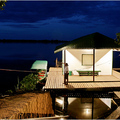
Yoray Liberman for The New York Times
Hot-air balloons float above the hills and rock formations of Cappadocia.
“WATCH your head,” warned my guide, Edip, as we ducked into a stone cave in the otherworldly Turkish region of Cappadocia. The ceiling, which was covered with black soot, was just a foot above our heads. “The third and fourth floors were used as kitchens,” Edip said, as we entered another cave with two troughs carved into the volcanic stone floor. “They also made wine here. It was their only real luxury.”
Spread across the middle of Turkey like a lunar landscape, Cappadocia is home to a bizarre field of anthill-like cones, rock-hewn churches and underground cities where Christians once hid to avoid persecution. It is a spectacular sight and one that has captivated travelers for centuries.
An area that has traditionally attracted backpackers and archaeology-minded tourists, Cappadocia is now going upscale and drawing a younger more sophisticated crowd. As evidence, in April the area welcomed its first true designer hotel, the Serinn House, which has been built around and carved into the area's soft rock like the subterranean chapels created centuries earlier.
Situated near sandy yellow cliffs in the town of Urgup, the Serinn has five guest rooms, each designed by the Istanbul architect Rifat Ergor to blend the caves' natural contours with contemporary features. In the largest suite (the hotel's only noncave room) a black chandelier by the Dutch design firm Moooi hangs over the bed and a red lounge chair by Ron Arad. My smaller cave room was no less design-savvy, with a colorful rug from Habitat, a light-blue Vitra chair, plastic drawers designed by Werner Aisslinger and Wi-Fi.
I didn't notice until the second day that there weren't any flat-screen televisions, but it hardly mattered. There were far better things to do, like having breakfast on the tranquil terrace where, every morning, freshly baked focaccia was served with bowls of cherries, apricots, yogurt, cheeses, tomatoes, cured ham and muesli.
But I didn't let breakfast keep me from exploring the nearby sights. You need at least three days to wander through the dusty, ancient villages scattered across Cappadocia and to survey the fantastic panorama of towering stalagmites that stretches across 50 square miles of sun-baked hills and valleys.
On that first morning I went to Pigeon Valley near the village of Uchisar, so named for the thousands of pigeon houses carved into the rock. It was a surreal vision: an outrageously phallic landscape straight out of a Salvador Dalí painting.
The conical formations are the result of volcanic eruptions that took place millions of years ago. Eons of wind, rain and other forces of nature have eaten away at the volcanic rock creating tufa, a soft and malleable stone. Many of these cones, known as fairy chimneys, contain caves and labyrinths.
As early as the third century, those chimneys became a hiding place for early Christians who fled persecution from the Romans, and then later from raiding Muslims. They dug deep into the rock, carving out underground cities that went eight stories below ground, as well as thousands of cave chapels and monastery cells.
As recently as 20 years ago, most of the cave dwellings were empty — abandoned for more modern, concrete homes. In the last several years, though, affluent Turks and foreigners have started turning them into second homes and, in a few cases, boutique hotels like the Cappadocia Cave Suites and the recently opened Anatolia Houses.
“It was the soap opera ‘Asmali Konak' that started it all,” said Laura Prusoff, an American who lives in the tiny Cappadocian village of Ortahisar, referring to a Turkish television series in 2002 and 2003 that was set in Cappadocia. “It made Cappadocia famous among Turks and put it on the map.”
Cappadocia is also becoming known as a great place for hot-air ballooning. On any given morning, it's possible to spot as many as 20 balloons in the sky. One morning, I watched two enormous balloons land on the back of separate trailers as 26 exhilarated clients drank glasses of Cloud Nine — Champagne with cherry juice.
Kaili Kidner, a British expatriate who owns Kapadokya Balloons with her husband, Lars-Eric More, said that it was the combination of amazing landscapes, consistent temperatures and a long season that made Cappadocia an ideal ballooning destination. “There's also the right kind of people who come here,” she added, “upmarket cultural tourists and adventure seekers.”
While tourism is booming, at least one tradition is dying out: rug weaving. “I give it 10 more years,” said Hasan Kalci, whose family has been selling handmade Turkish carpets for three generations. Interestingly, it's not tourism that is destroying the craft, but social progress. “Now that it's mandatory that all girls go to school, there are very few women left willing to stay at home and weave a carpet.”
So, like other entrepreneurs in the region, Mr. Kalci has branched out into luxury tourism, opening the Anatolian Houses in the town of Goreme in May 2006. “The future of Cappadocia's economic success is in higher standards and sophisticated tourists,” Mr. Kalci said, and then confided: “I've heard that Shakira might be coming to Cappadocia after her concert in Istanbul.”
It ended up being a rumor; the Colombian singer went to the Turkish coast instead. But with a descendant of Tolstoy booked into his presidential suite, Mr. Kalci wasn't that disappointed.
VISITOR INFORMATION
Turkish Airlines flies from Kennedy Airport to Kayseri, with a plane change in Istanbul. Fares start at about $1,000 for travel in October. Car rentals are also available at the airport, though it's a good idea to go with a guide for at least one full day. One of the more reputable outfits, Argeus (90-384-341-4688; www.argeus.com.tr), offers a full-day tour of Cappadocia's moonscape at $145 per person for a group of two.
WHERE TO STAY
The recently opened Serinn House in Urgup (Esbelli Sokak 36; 90-384-341-6076; www.serinnhouse.com) is a chic five-room property that offers cave rooms, glass-walled showers and Wi-Fi. Rooms start $120 a night, including breakfast.
The luxurious Anatolian Houses (Gaferli Mah, Goreme; 90-384-271-2463; www.anatolianhouses.com), which opened last year, has 19 rooms outfitted with whirlpool tubs and Anatolian antiques, including several suites in the fairy chimneys. Rates start at $300 a night.
WHERE TO EAT
Alaturca in Goreme (90-384-271-2882; www.goremealaturca.com) serves big portions of traditional Anatolian cuisine.
Ziggy's in Urgup (Yunak Mahallesi Tevfik Fikret Caddesi 24; 90-384-341-7107) is a stylish restaurant that occupies three floors of an old stone building. A favorite of local expatriates, it serves fresh salads and pasta.
Somine in Urgup (Cumhuriyet Meydani 9; 90-384-341-8442; www.sominerestaurant.com), with a rooftop terrace, specializes in traditional Turkish cuisine.
WHERE TO SHOP
Kaya Seramik in Avanos (Eski Nevsehir Yolu Uzeri, 90-384-511-2374; www.gurayseramik.com.tr) sells colorful ceramic platters and traditional Iznik tiles.






